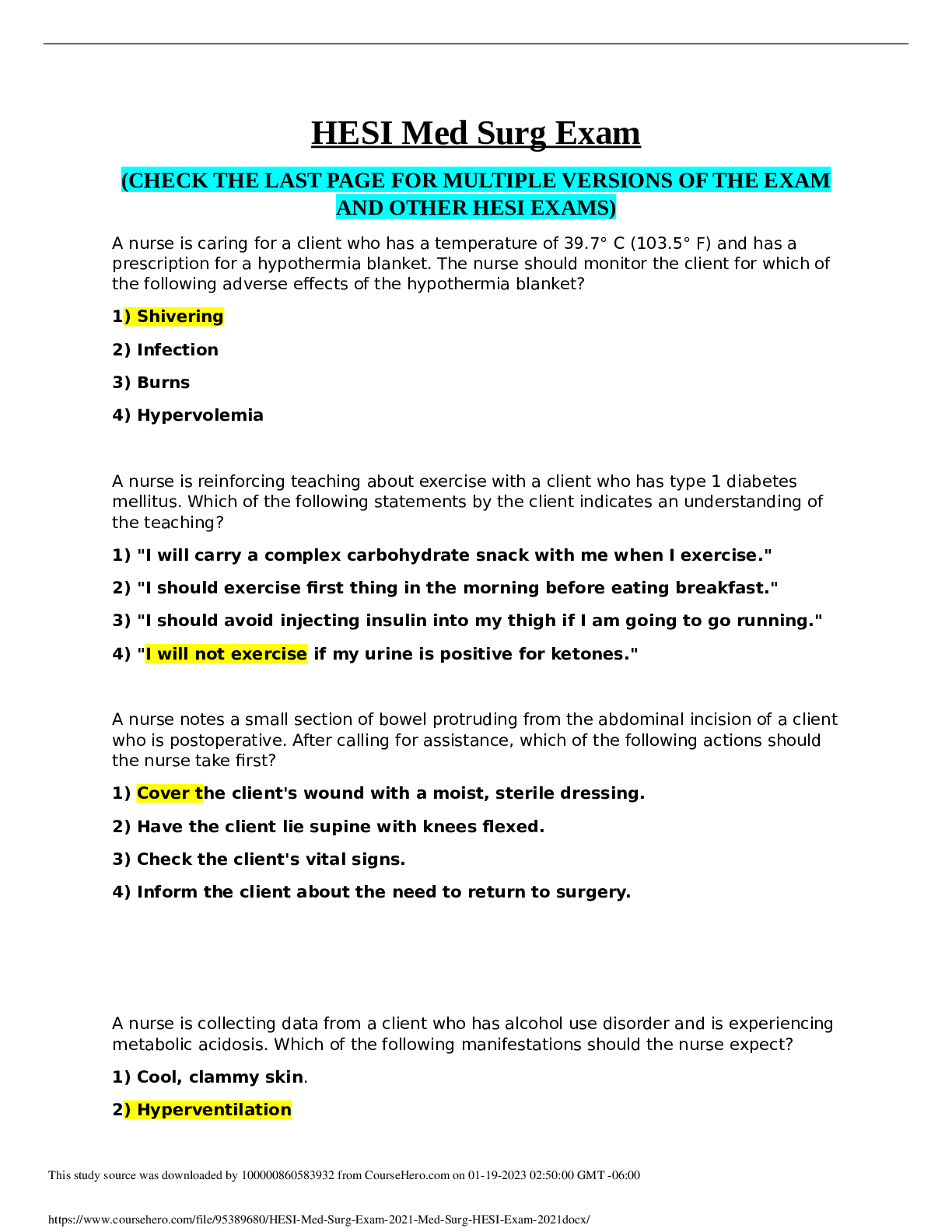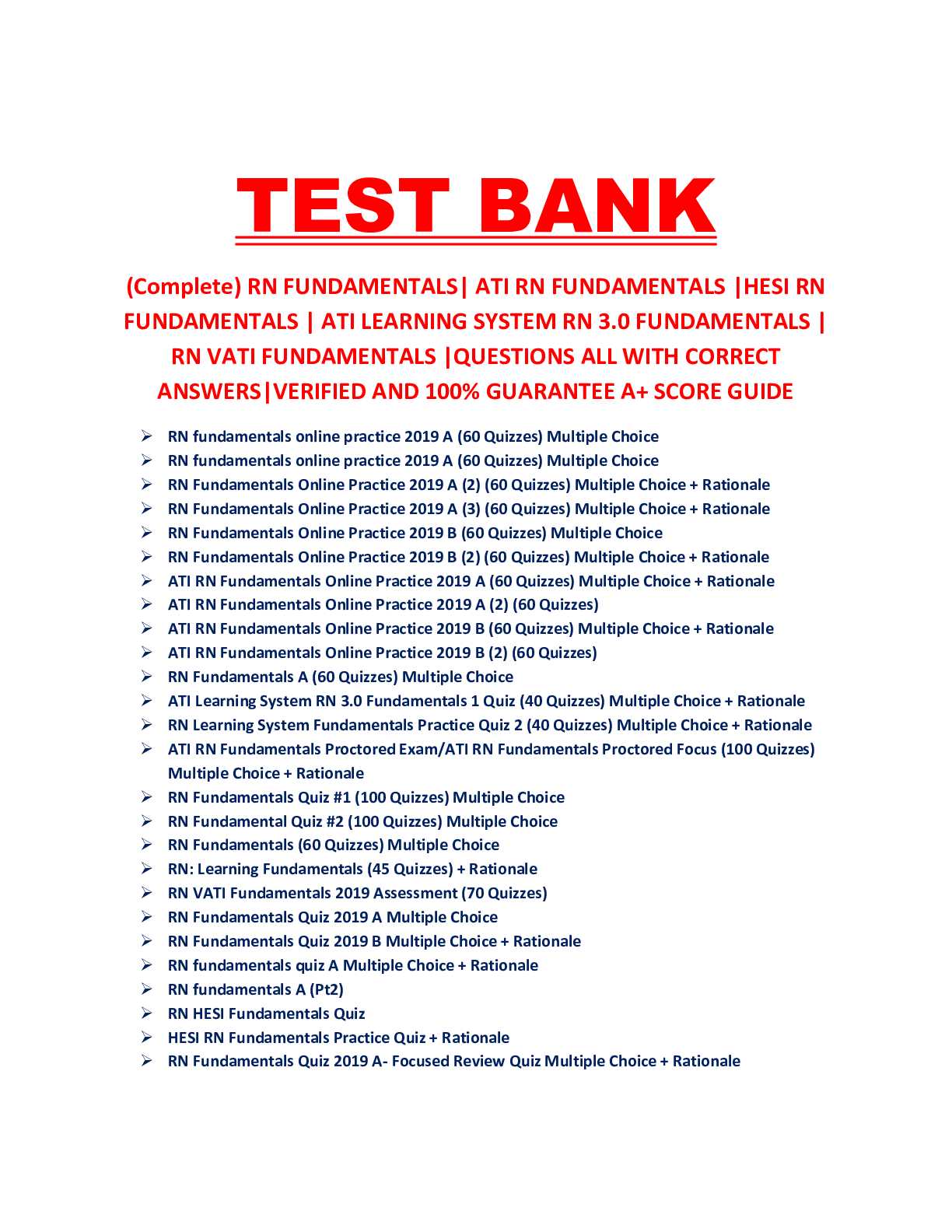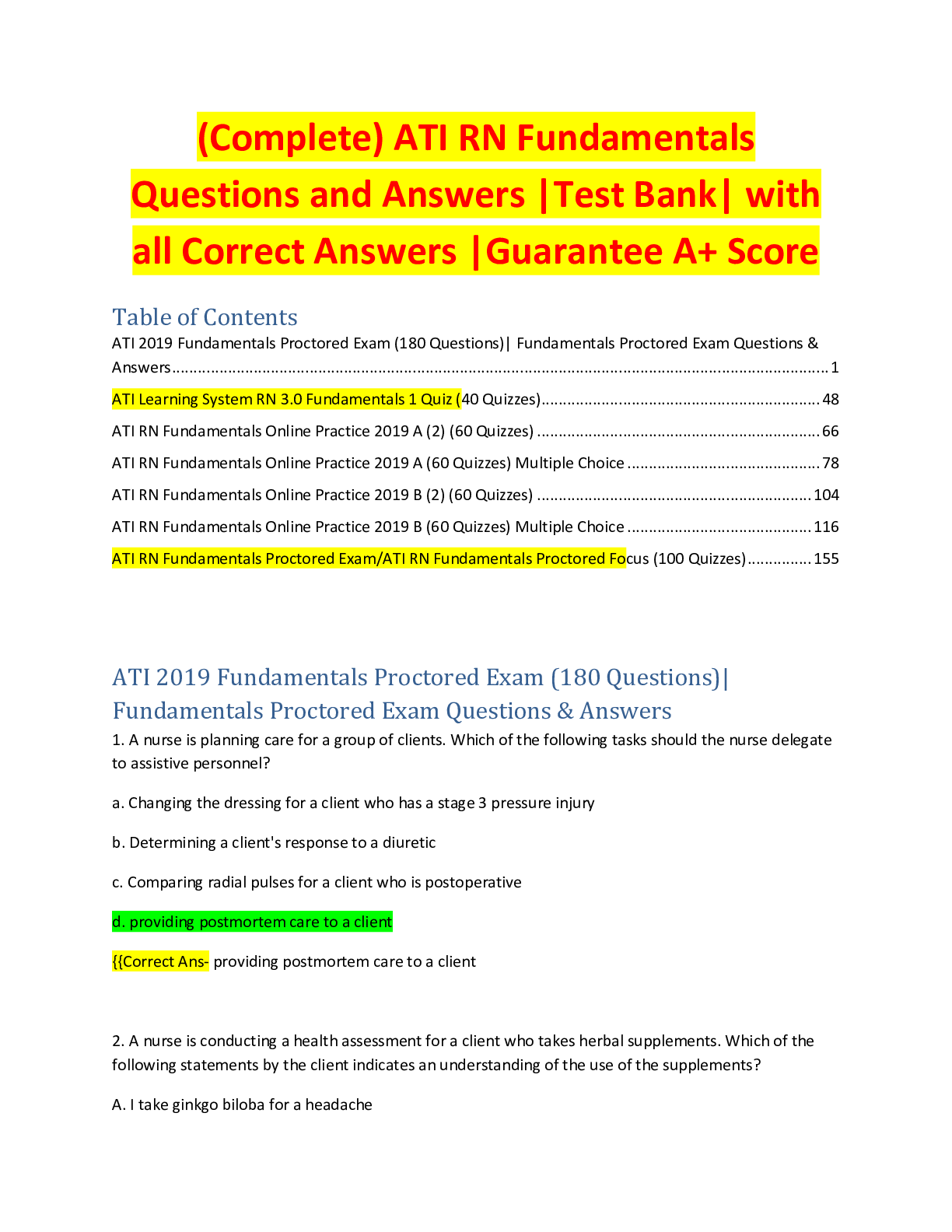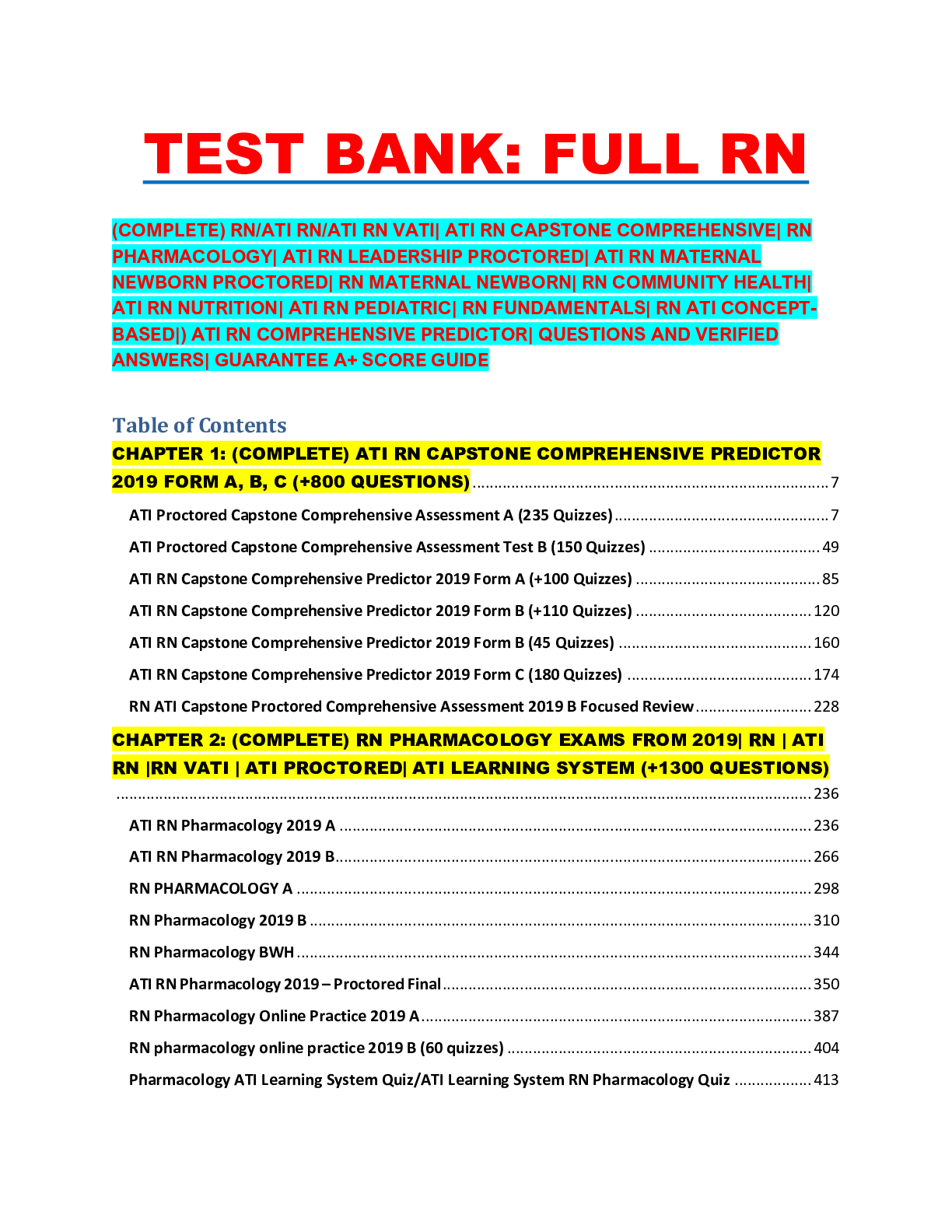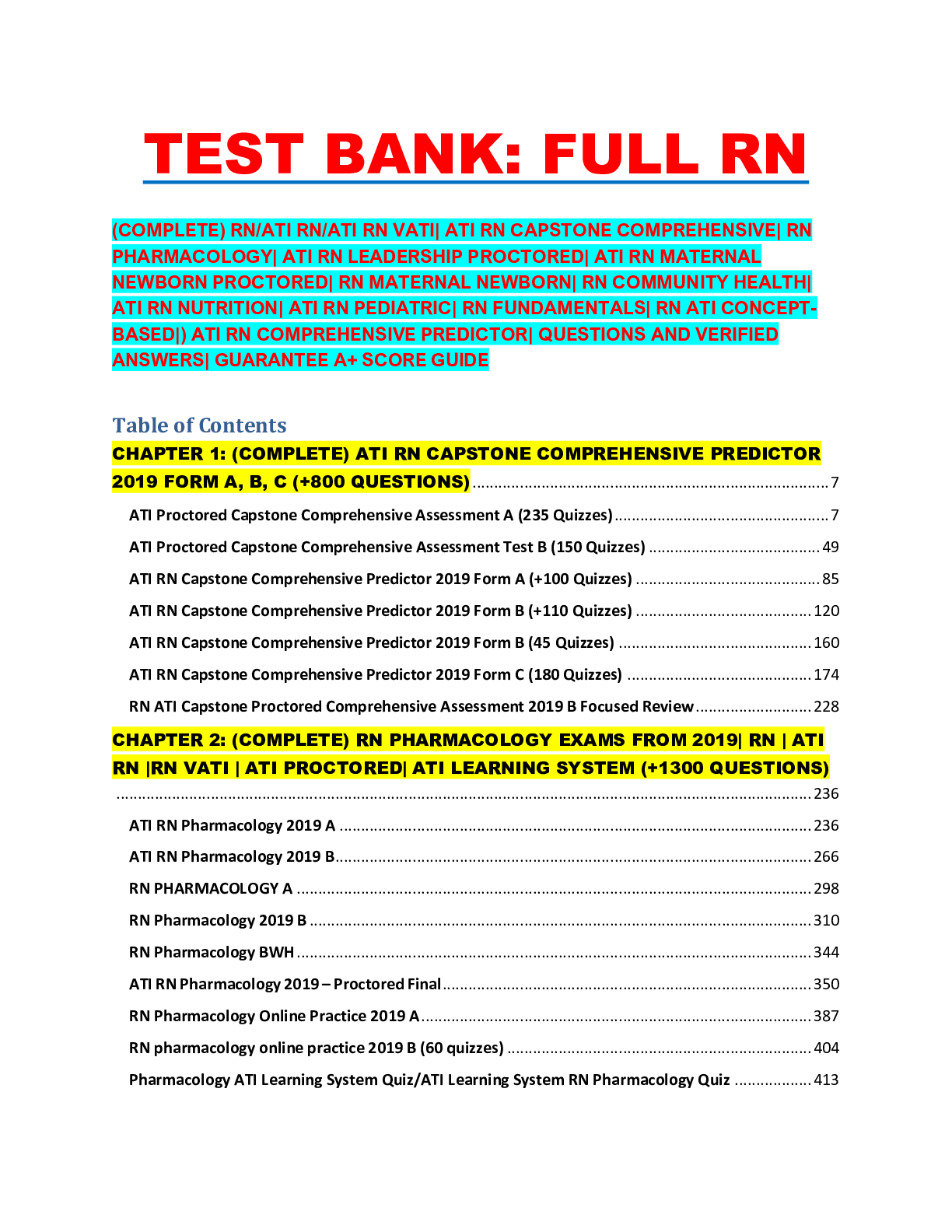Med-Surg II HESI Test Bank 2023 > TEST BANK > COMPREHENSIVE MED-SURG II HESI TEST BANK (+ 560 QUESTIONS WITH ALL CORRECT ANSWERS (2023-2024 GUARAN (All)
COMPREHENSIVE MED-SURG II HESI TEST BANK (+ 560 QUESTIONS WITH ALL CORRECT ANSWERS (2023-2024 GUARANTEE A+ SCORE GUIDE FOR YOUR FINAL)
Document Content and Description Below
COMPREHENSIVE MED-SURG II HESI TEST BANK (+ 560 QUESTIONS WITH ALL CORRECT ANSWERS (2023-2024 GUARANTEE A+ SCORE GUIDE FOR YOUR FINAL) 1. A patient is admitted to the hospital with a diagnosis of d... iarrhea with dehydration. The nurse recognizes that increased peristalsis resulting in diarrhea can be related to a. sympathetic inhibition. b. mixing and propulsion. c. sympathetic stimulation. d. parasympathetic stimulation. Correct answer: d Rationale: Peristalsis is increased by parasympathetic stimulation. 2. A patient has an elevated blood level of indirect (unconjugated) bilirubin. One cause of this finding is that a. the gallbladder is unable to contract to release stored bile. b. bilirubin is not being conjugated and excreted into the bile by the liver. c. the Kupffer cells in the liver are unable to remove bilirubin from the blood. d. there is an obstruction in the biliary tract preventing flow of bile into the small intestine. Correct answer: b Rationale: Bilirubin is a pigment derived from the breakdown of hemoglobin and is insoluble in water. Bilirubin is bound to albumin for transport to the liver and is referred to as unconjugated. An indirect bilirubin determination is a measurement of unconjugated bilirubin, and the level may be elevated in hepatocellular and hemolytic conditions. 3. As gastric contents move into the small intestine, the bowel is normally protected from the acidity of gastric contents by the a. inhibition of secretin release. b. release of bicarbonate by the pancreas. c. release of pancreatic digestive enzymes. d. release of gastrin by the duodenal mucosa. Correct answer: b Rationale: The hormone secretin stimulates the pancreas to secrete fluid with a high concentration of bicarbonate. This alkaline secretion enters the duodenum and neutralizes acid in the chyme. 4. A patient is jaundiced and her stools are clay colored (gray). This is most likely related to a. decreased bile flow into the intestine. b. increase production of urobilinogen. c. increased production of cholecystokinin. d. increased bile and bilirubin in the blood. Correct answer: a Rationale: Bile is produced by the hepatocytes and is stored and concentrated in the gallbladder. When bile is released from the common bile duct, it enters the duodenum. In the intestines, bilirubin is reduced to stercobilinogen and urobilinogen by bacterial action. Stercobilinogen accounts for the brown color of stool. Stools may be clay- colored if bile is not released from the common bile duct into the duodenum. Jaundice may result if the bilirubin level in the blood is elevated. 5. An 80-year-old man states that, although be adds a lot of salt to his food, it still does not have much taste. The nurse's response is based on the knowledge that the older adult a. should not experience changes in taste. b. has a loss of taste buds, especially for sweet and salty. c. has some loss of taste but no difficulty chewing food. d. loses the sense of taste because the ability to smell is decreased. Correct answer: b Rationale: Older adults have decreased numbers of taste buds and a decreased sense of smell. These age-related changes diminish the sense of taste (especially of salty and sweet substances). 6. When the nurse is assessing the health perception-health maintenance pattern as related to GI function, an appropriate question to ask is a. "What is your usual bowel elimination pattern?" b. "What percentage of your income is spent on food?" c. "Have you traveled to a foreign country in the last year?" d. "Do you have diarrhea when you are under a lot of stress?" Correct answer: c Rationale: When assessing gastrointestinal function in relation to the health perception- health management pattern, the nurse should ask the patient about recent foreign travel with possible exposure to hepatitis, parasitic infestation, or bacterial infection. 7. During an examination of the abdomen the nurse should a. position the patient in the supine position with the head of the bed flat and knees straight. b. listen in the epigastrium and all four quadrants for 2 minutes for bowel sounds. c. use the following order of techniques: inspection, palpation, percussion, auscultation. d. describe bowel sounds as absent if no sound is heard in the lower right quadrant after 2 minutes. Correct answer: b Rationale: The nurse should listen in the epigastrium and all four quadrants for bowel sounds for at least 2 minutes. The patient should be in the supine position and should slightly flex the knees; the head of the bed should be raised slightly. During examination of the abdomen, the nurse auscultates before performing percussion and palpation because the latter procedures may alter the bowel sounds. Bowel sounds cannot be described as absent until no sound is heard for 5 minutes in each quadrant. 8. A normal physical assessment finding of the GI system is/are (select all that apply) a. nonpalpable liver and spleen. b. borborygmi in upper right quadrant. c. tympany on percussion of the abdomen. d. liver edge 2 to 4 cm below the costal margin. e. finding of a firm, nodular edge on the rectal examination. Correct answers: a, c Rationale: Normal assessment findings for the gastrointestinal system include a nonpalpable liver and spleen and generalized tympany on percussion. Normally, bowel sounds are high pitched and gurgling; loud gurgles indicate hyperperistalsis and are called borborygmi (stomach growling). If the patient has chronic obstructive pulmonary disease, large lungs, or a low-set diaphragm, the liver may be palpated 0.4 to 0.8 inch (1 to 2 cm) below the right costal margin. On palpation, the rectal wall should be soft and smooth and should have no nodules. 9. In preparing a patient for a colonoscopy, the nurse explains that a. a signed permit is not necessary. b. sedation may be used during the procedure. c. only one cleansing enema is necessary for preparation. d. a light meal should be eaten the day before the procedure. Correct answer: b Rationale: Sedation is induced during a colonoscopy. A signed consent form is necessary for a colonoscopy. A cathartic or enema is administered the night before the procedure, and more than one enema may be necessary. Patients may need to be kept on clear liquids 1 to 2 days before the procedure. 10. A patient receives atropine, an anticholinergic drug, in preparation for surgery. The nurse expects this drug to affect the GI tract by doing what? a. Increasing gastric emptying b. Relaxing pyloric and ileocecal sphincters c. Decreasing secretions and peristaltic action d. Stimulation the nervous system of the GI tract Correct answer: c Rationale: The parasympathetic nervous system stimulates activity of the gastrointestinal (GI) tract, increasing motility and secretions and relaxing sphincters to promote movement of contents. A drug that blocks this activity decreases secretions and peristalsis, slows gastric emptying, and contracts sphincters. The enteric nervous system of the GI tract is modulated by sympathetic and parasympathetic influence. 11. After eating, a patient with an inflamed gallbladder experiences pain caused by contraction of the gallbladder. What is the mechanism responsible for this action? a. Production of bile by the liver b. Production of secretin by the duodenum c. Release of gastrin from the stomach antrum d. Production of cholecystokinin by the duodenum Correct answer: d Rationale: Cholecystokinin is secreted by the duodenal mucosa when fats and amino acids enter the duodenum and stimulate the gallbladder to release bile to emulsify the fats for digestion. The bile is produced by the liver but stored in the gallbladder. Secretin is responsible for stimulating pancreatic bicarbonate secretion and gastrin increases gastric motility and acid secretion. 12. Priority Decision: When caring for a patient who has had most of the stomach surgically removed, what is important for the nurse to teach the patient? a. Extra iron will need to be taken to prevent anemia. b. Avoid foods with lactose to prevent bloating and diarrhea. c. Lifelong supplementation of cobalamin (vitamin B12) will be needed. d. Because of the absence of digestive enzymes, protein malnutrition is likely. Correct answer: c Rationale: The stomach secretes intrinsic factor, necessary for cobalamin (vitamin B12) absorption in the intestine. When part or all of the stomach is removed, cobalamin must be supplemented for life. The other options will not be a problem. 13. A 68-year-old patient is in the office for a physical. She notes that she no longer has regular bowel movements. Which suggestion by the nurse would be most helpful to the patient? a. Take an additional laxative to stimulate defecation. b. Eat less acidic foods to enable the gastrointestinal system to increase peristalsis. c. Eat less food at each meal to prevent feces from backing up related to slowed peristalsis. d. Attempt defecation after breakfast because gastrocolic reflexes increase colon peristalsis at that time. Correct answer: d Rationale: When food inters the stomach and duodenum, the gastrocolic and duodenocolic reflexes are initiated and are more active after the first daily meal. Additional laxatives or laxative abuse contribute to constipation in older adults. Decreasing food intake is not recommended, as many older adults have a decreased appetite. Fibre and fluids should be increased. 14. Which digestive substances are active or activated in the stomach (select all that apply)? a. Bile b. Pepsin c. Gastrin d. Maltase e. Secretin f. Amylase Correct answer: b, c Rationale: Pepsinogen is changed to pepsin by acidity of the stomach, where it begins to break down proteins. Gastrin stimulates gastric acid secretion and motility and maintains lower esophageal sphincter tone. The stomach also secretes lipase for fat digestion.Bile is secreted by the liver and stored in the gallbladder for emulsifying fats. Maltase is secreted in the small intestine and converts maltose to glucose. Secretin is secreted y the duodenal mucosa and inhibits gastric motility and acid secretion. Amylase is secured in the small intestine and by the pancreas for carbohydrate digestion. 15. What problem should the nurse assess the patient for if the patient was on prolonged antibiotic therapy? a. Coagulation problems b. Elevated serum ammonia levels c. Impaired absorption of amino acids d. Increased mucus and bicarbonate secretion Correct answer: a Rationale: Bacteria int he colon (1) synthesize vitamin K, which is needed for the production of prothrombin by the liver and (2) deaminate undigested or non absorbed proteins, producing ammonia, which is converted to urea by the liver. A reduction in normal flora bacteria by antibiotic therapy can lead to decreased vitamin K, resulting in decreased prothrombin and coagulation problems. Bowel bacteria do not influence protein absorption or the secretion of mucus. 16. How will an obstruction at the ampulla of Vater affect the digestion of all nutrients? a. Bile is responsible for emulsification of all nutrients and vitamins. b. Intestinal digestive enzymes are released through the ampulla of Vater. c. Both bile and pancreatic enzymes enter the duodenum at the ampulla of Vater. d. Gastric contents can ply pass to the duodenum when the ampulla of Vater is open. Correct answer: c Rationale: The ampulla of Vater is the site where the pancreatic duct and common bile duct enter the duodenum and the opening and closing of the ampulla is controlled by the sphincter of Oddi. Because bile from the common bile duct is needed for emulsification of fat to promote digestion and pancreatic enzymes from the pancreas are needed for digestion of all nutrients, a blockage at this point would affect the digestion of all nutrients. Gastric contents pass into the duodenum through the pylorus or pyloric valve. 17. What is a clinical manifestation of age-related changes in the GI system that the [Show More]
Last updated: 11 months ago
Preview 1 out of 118 pages

Reviews( 0 )
Document information
Connected school, study & course
About the document
Uploaded On
May 26, 2023
Number of pages
118
Written in
Additional information
This document has been written for:
Uploaded
May 26, 2023
Downloads
0
Views
41

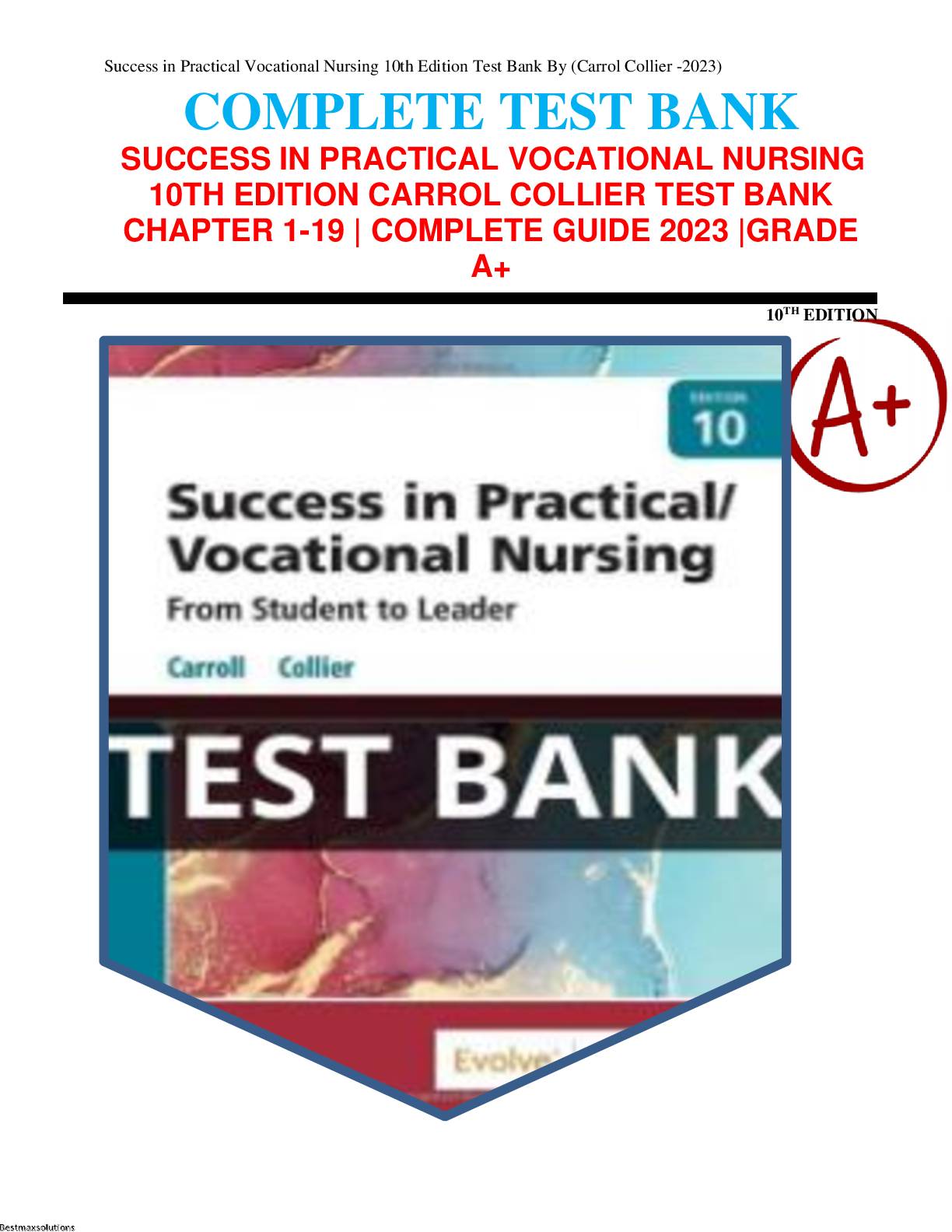
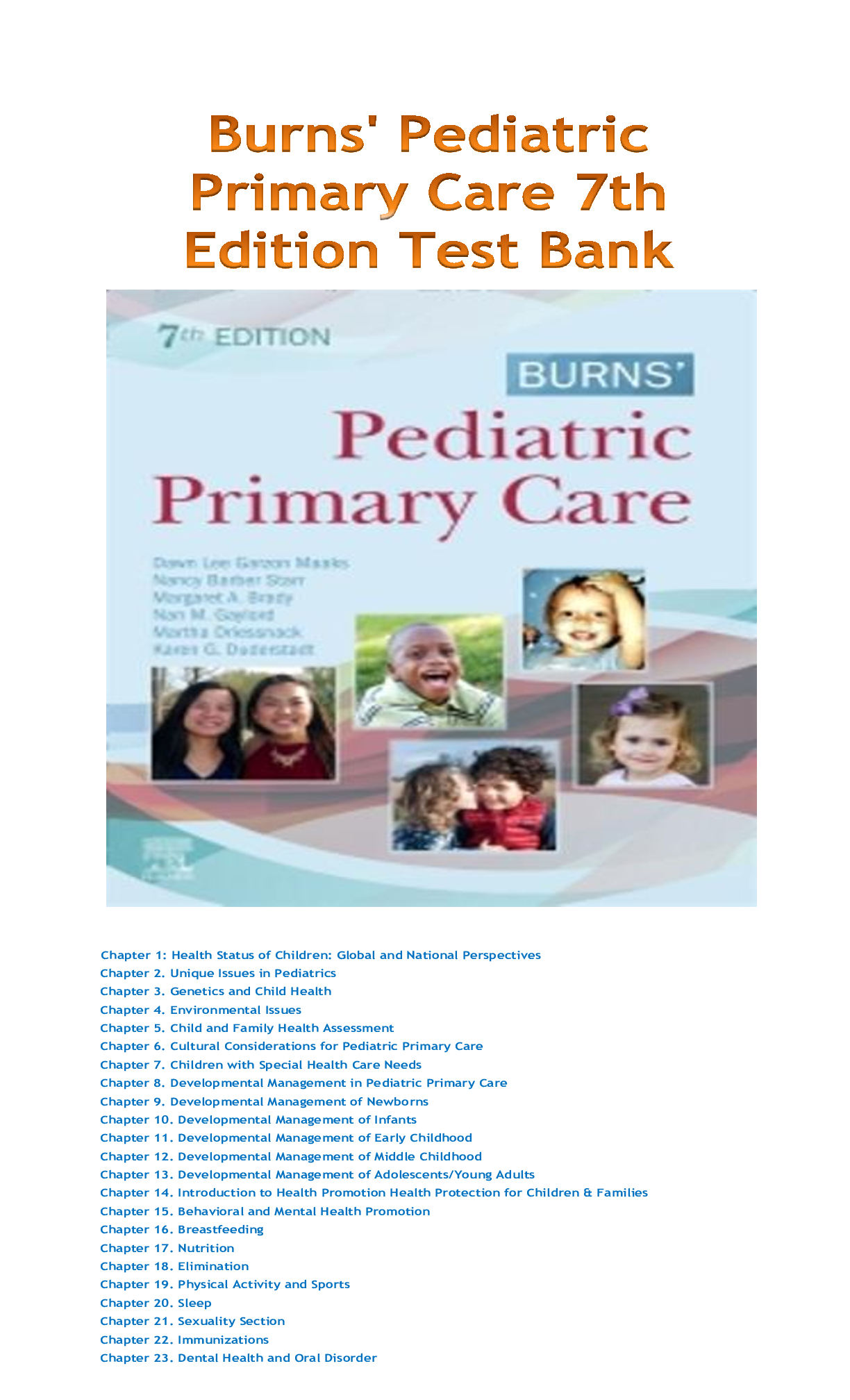



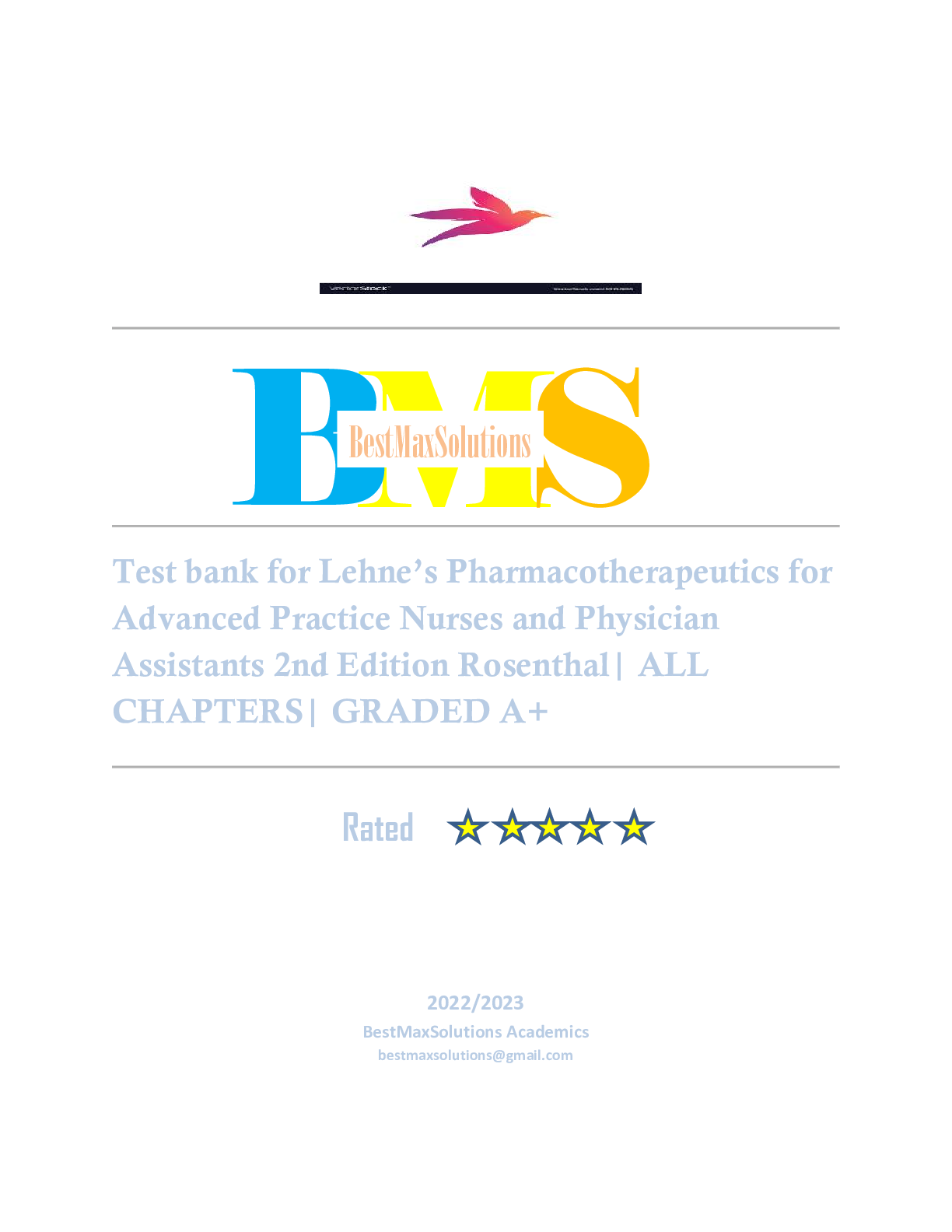


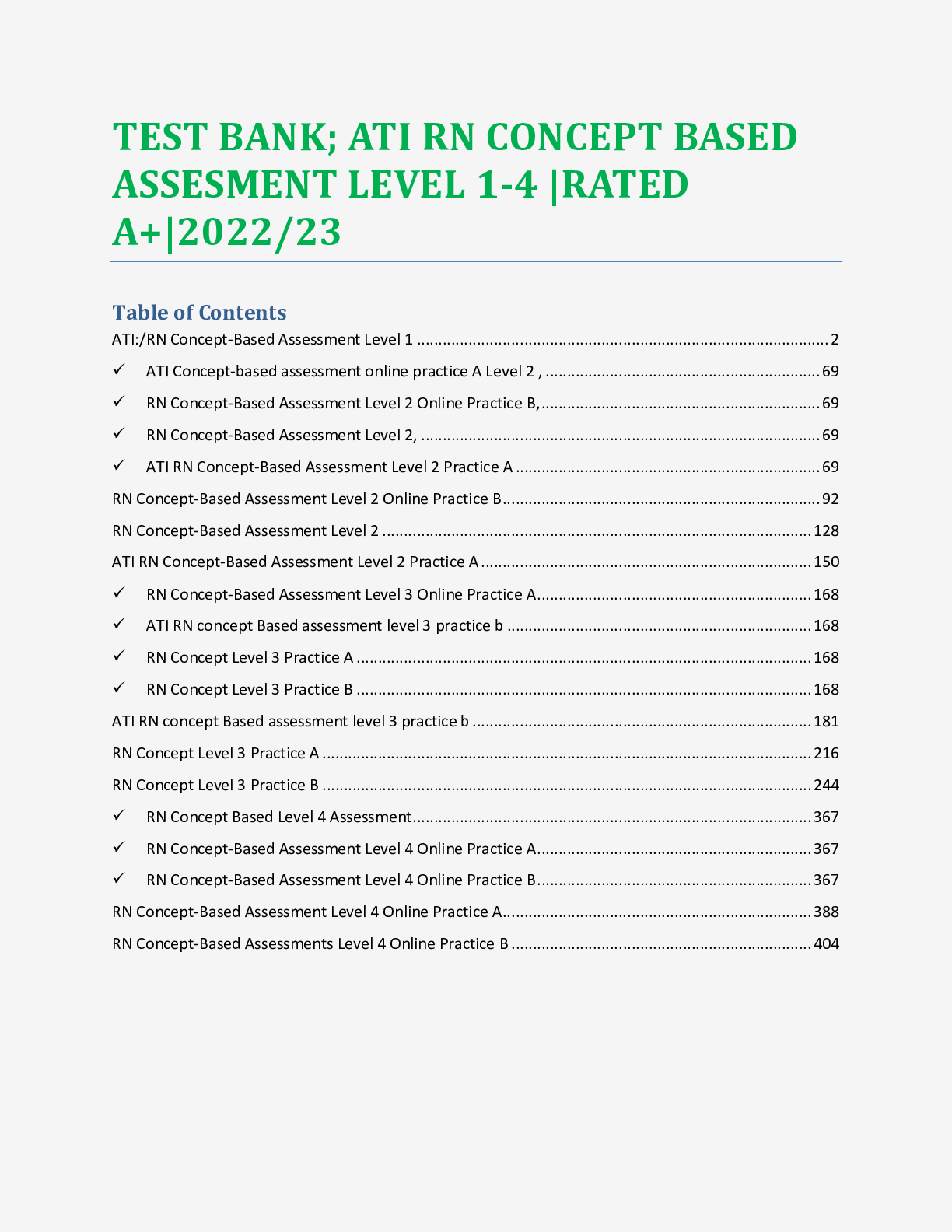
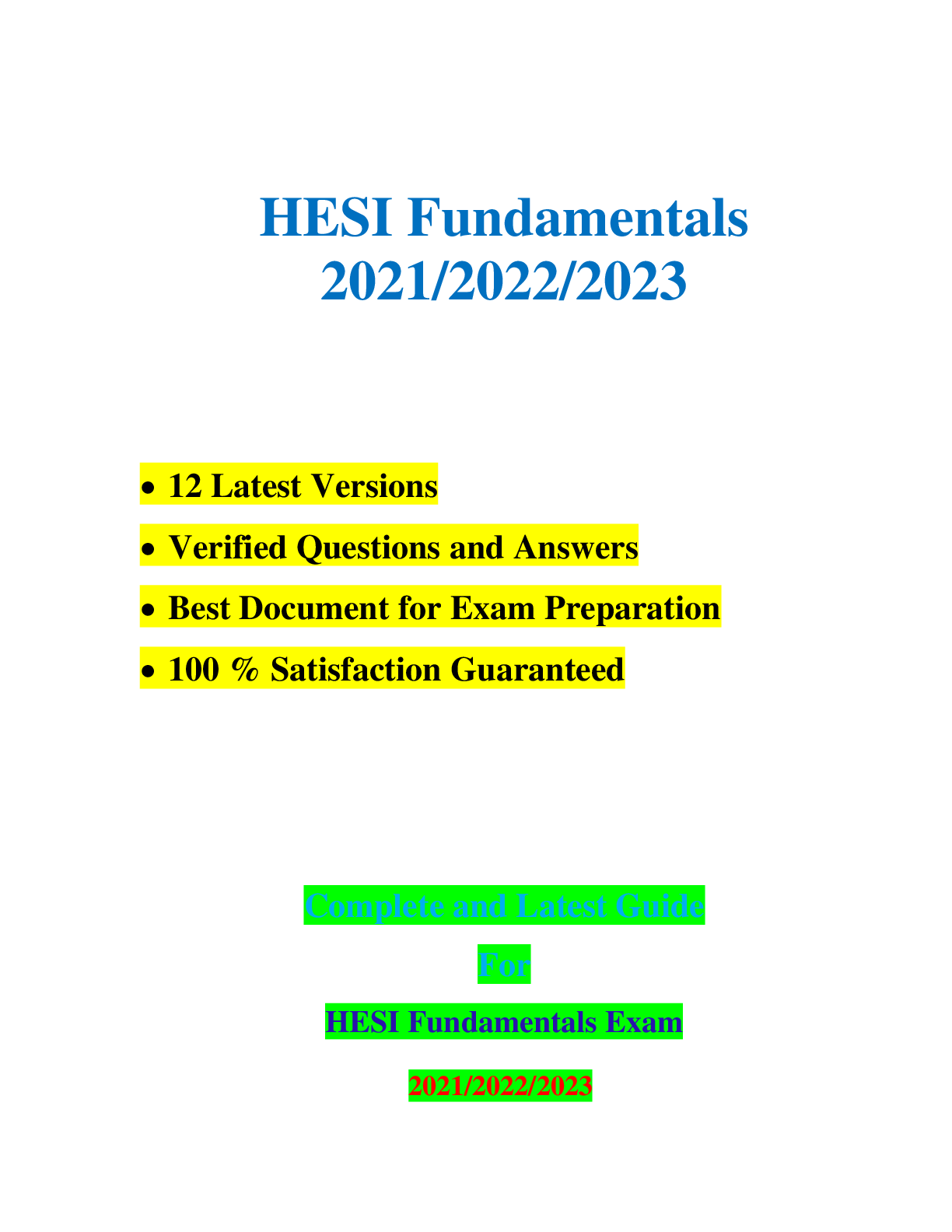
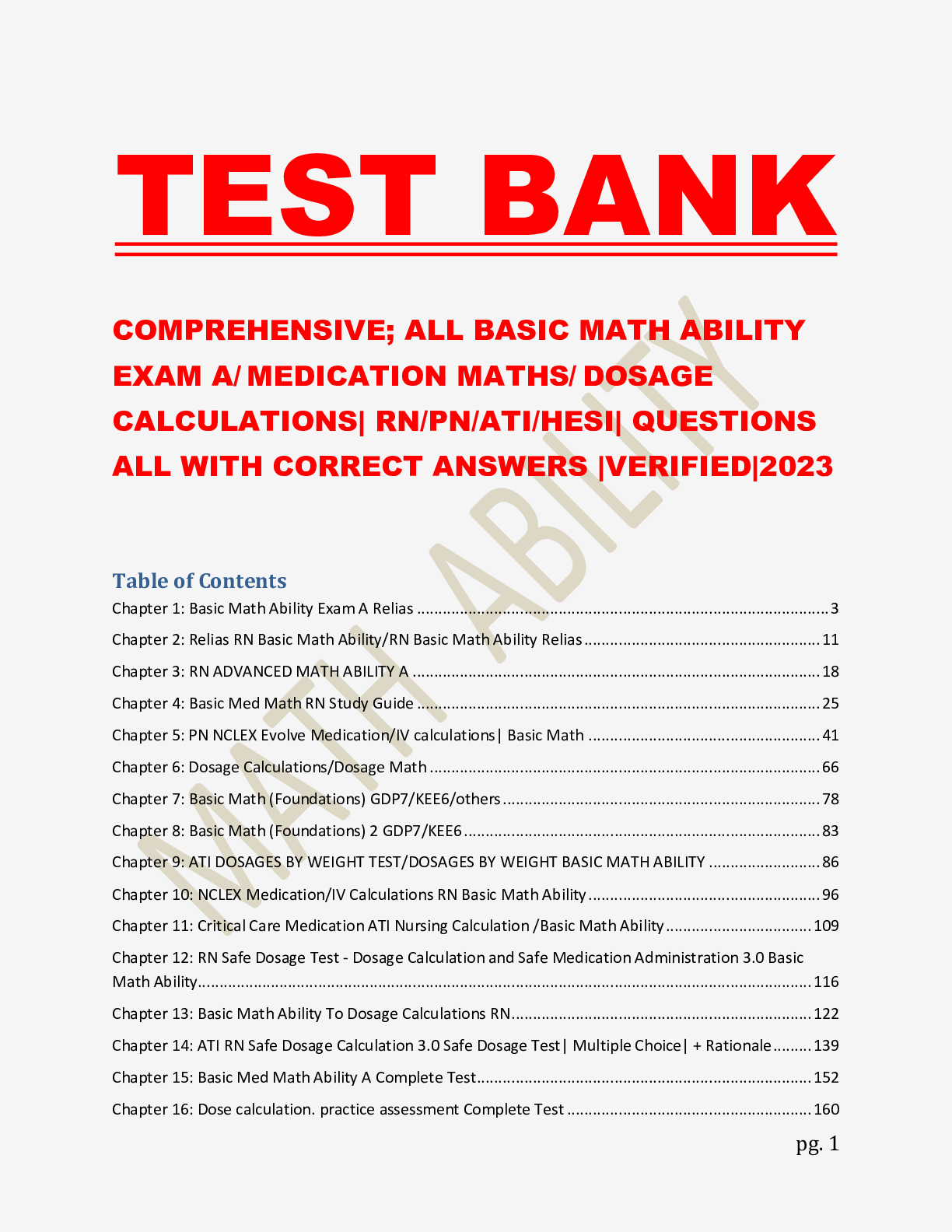

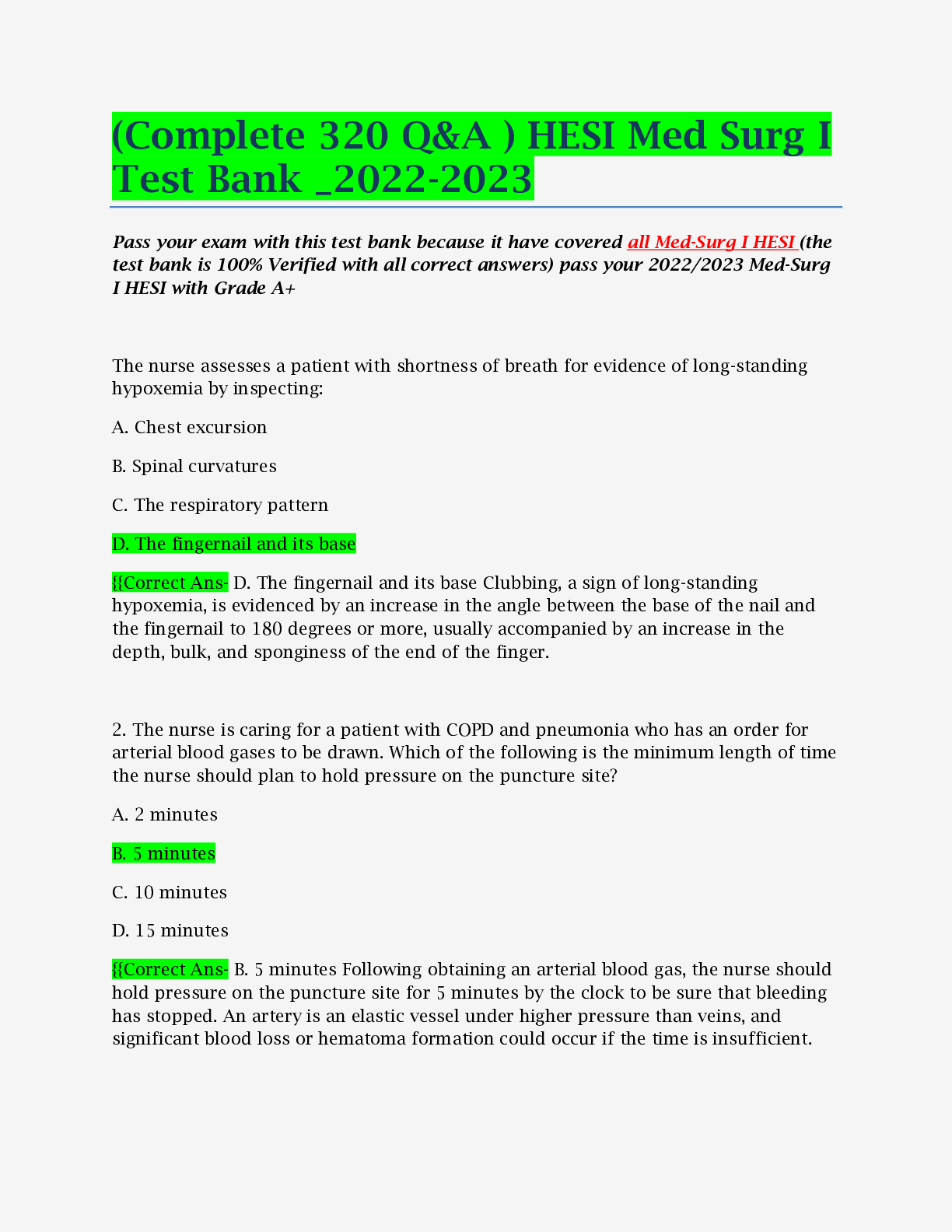
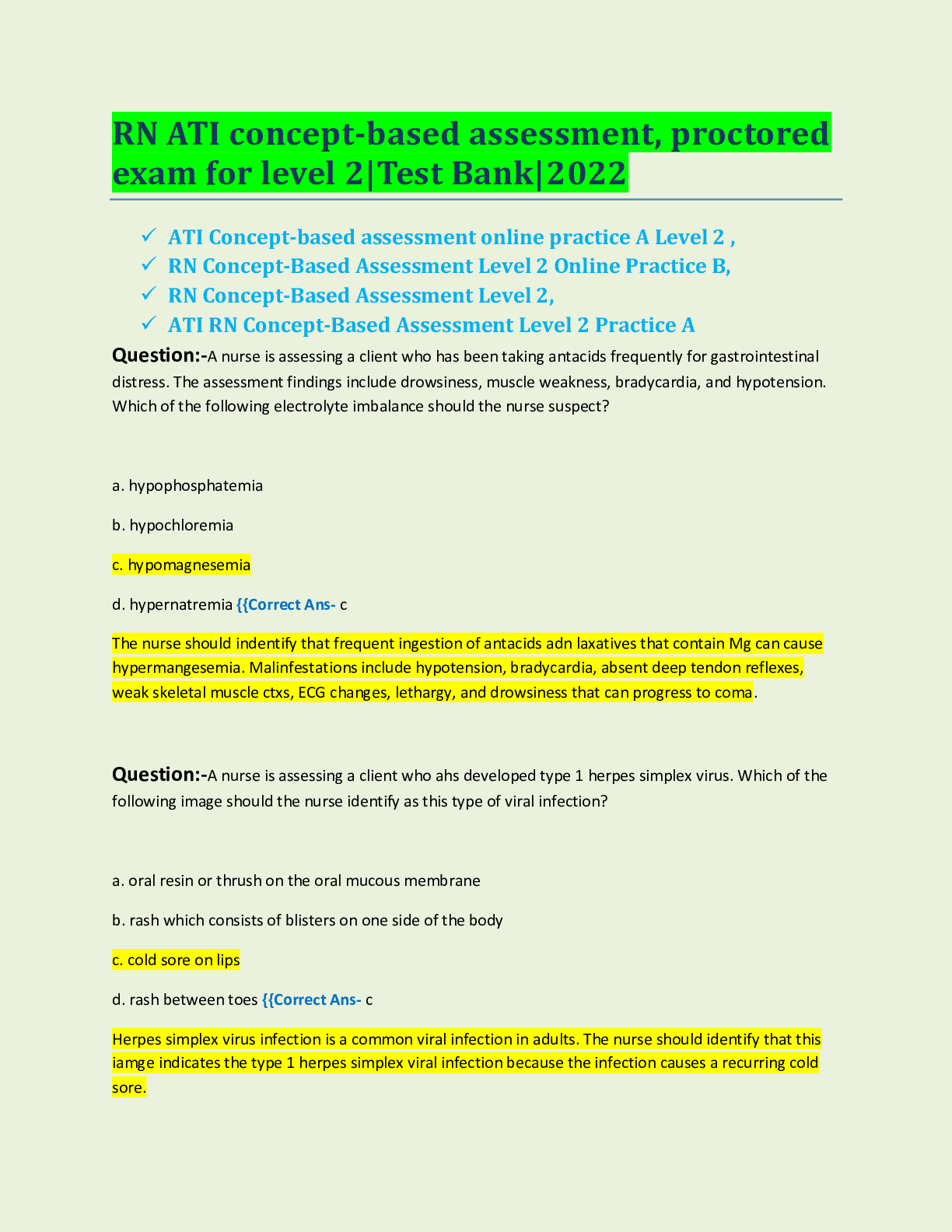
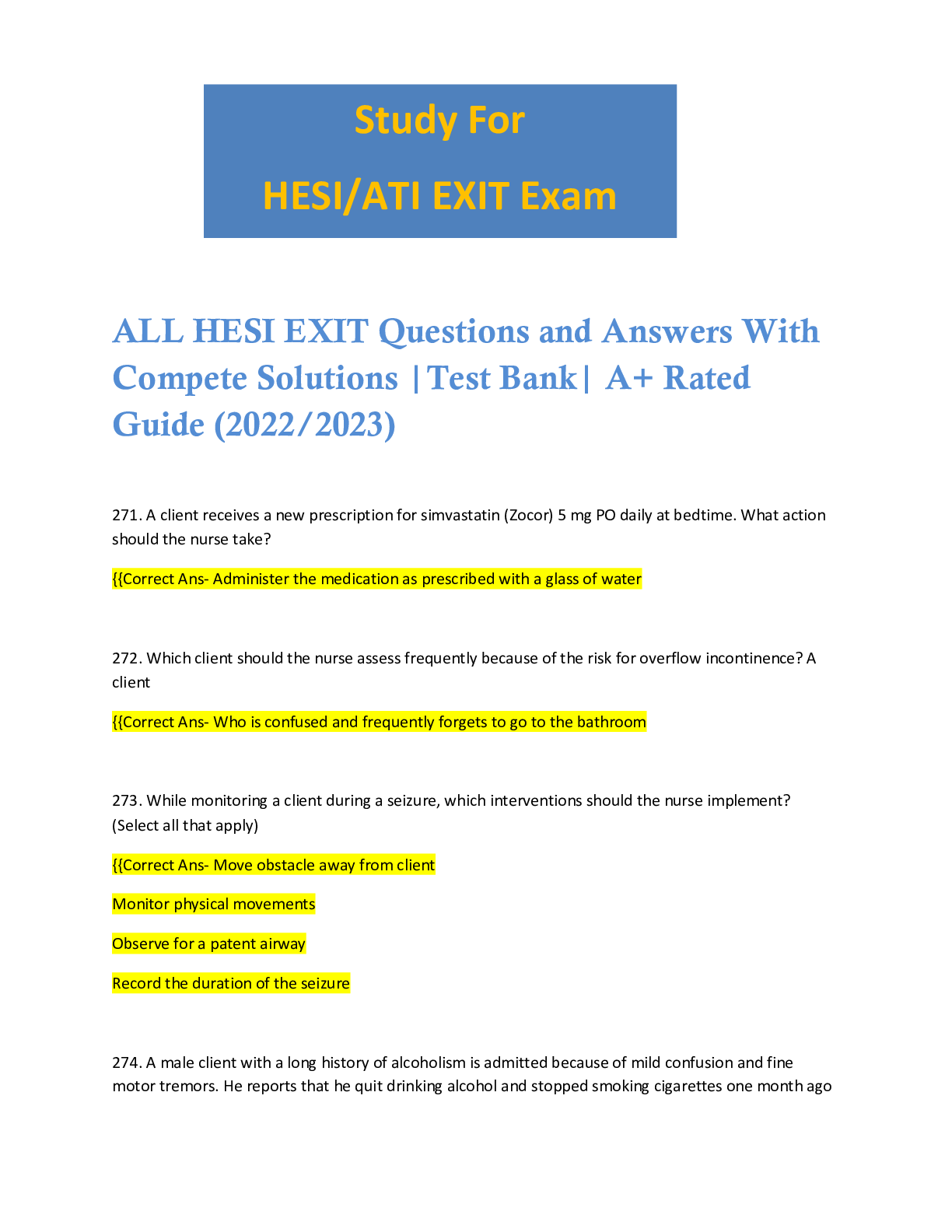



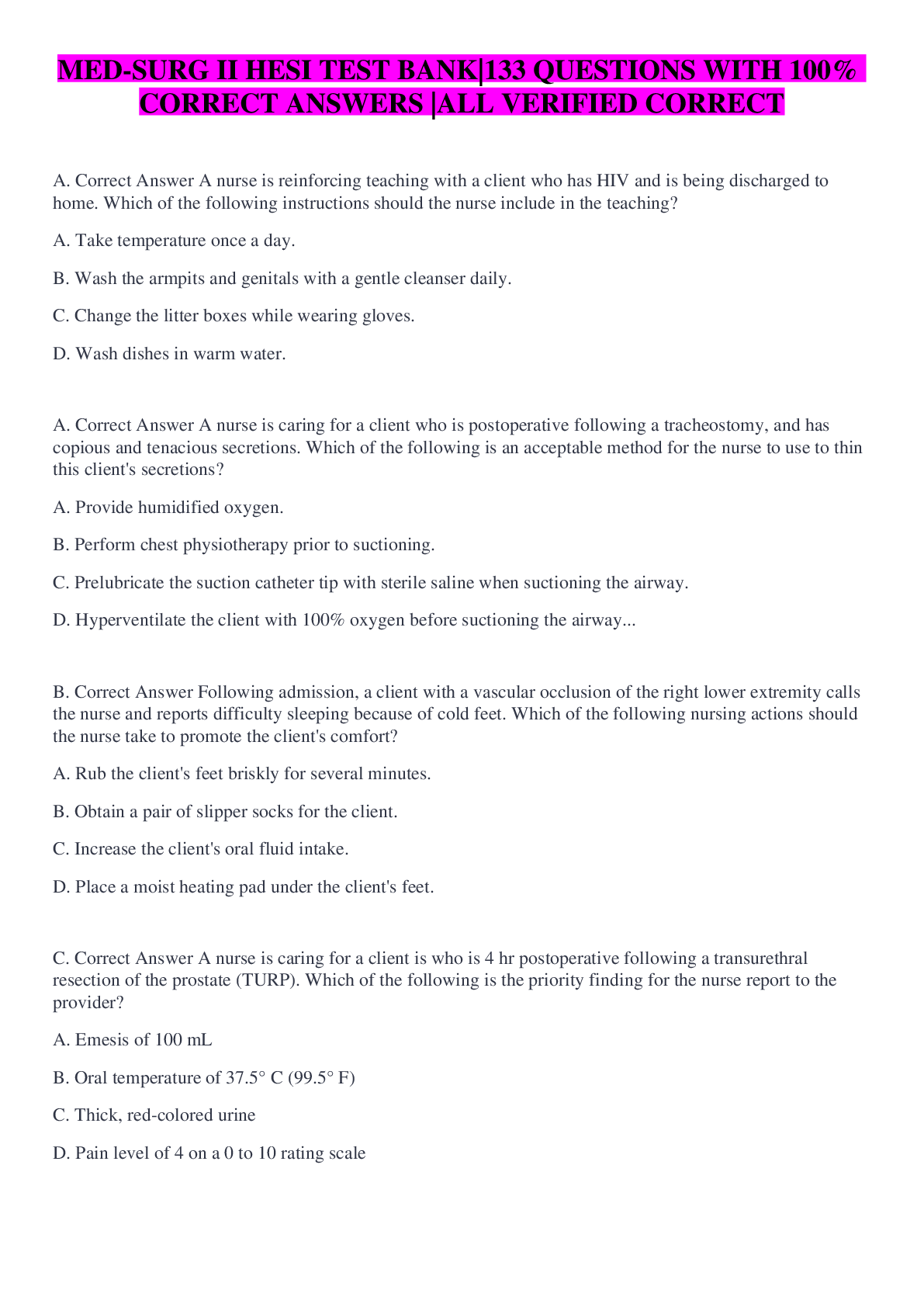
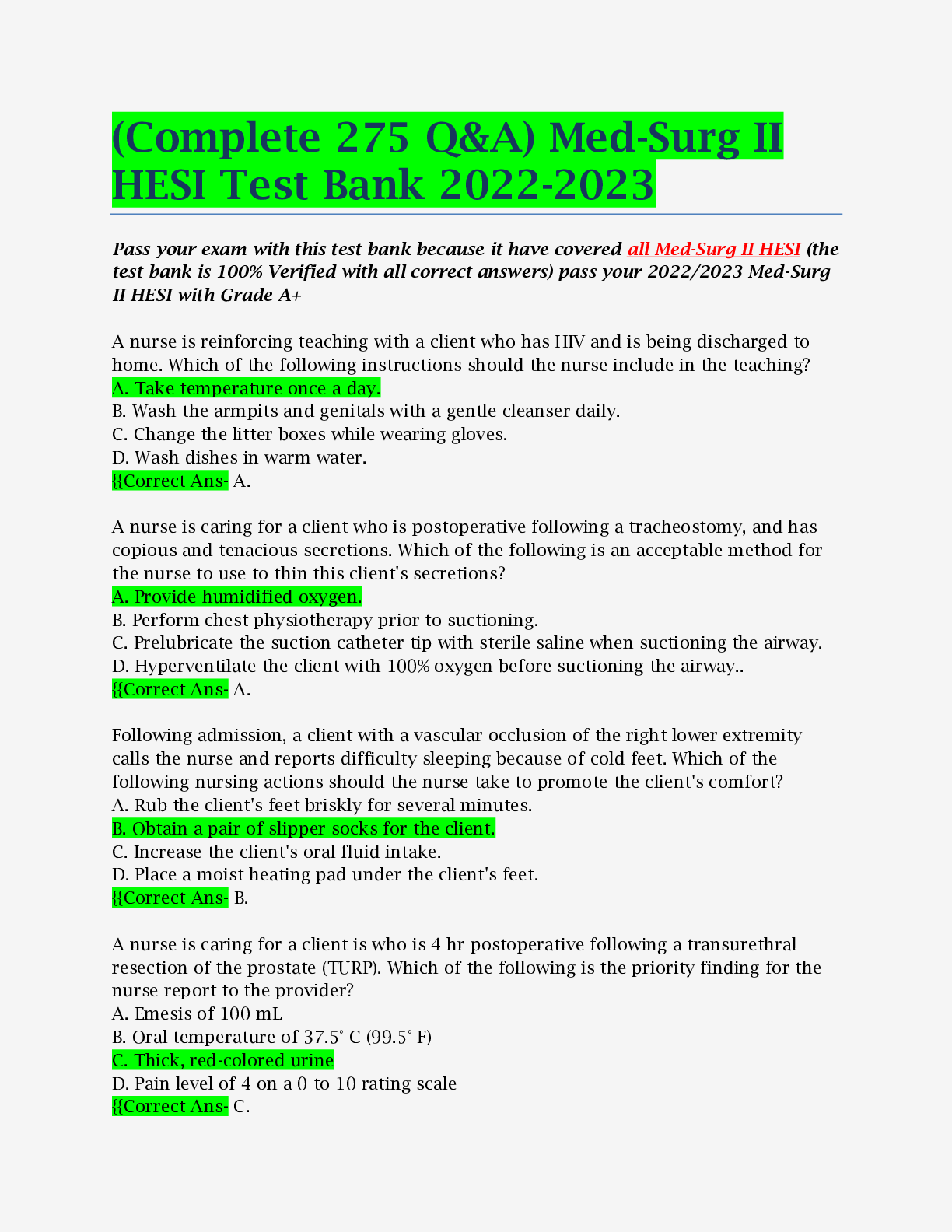
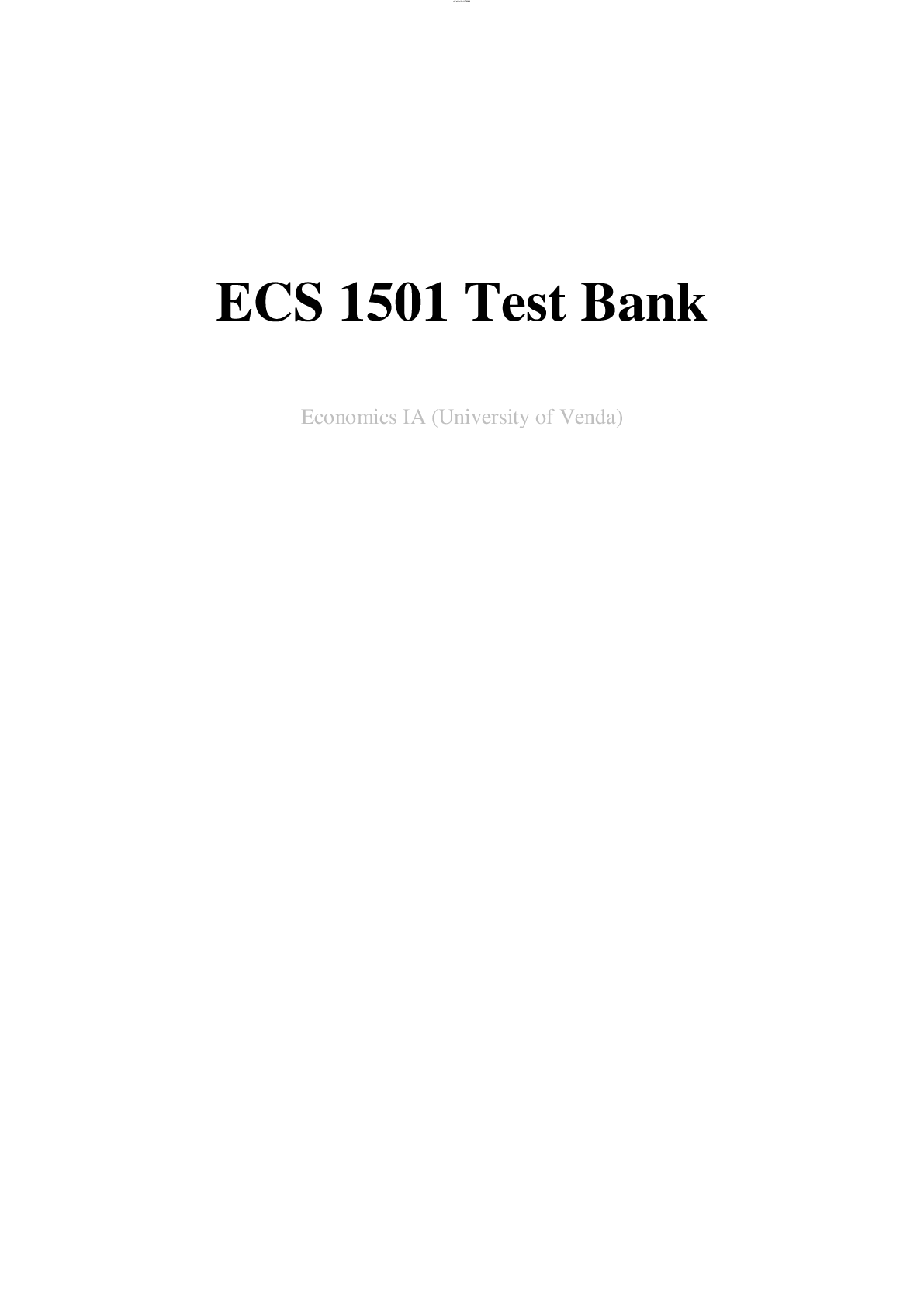
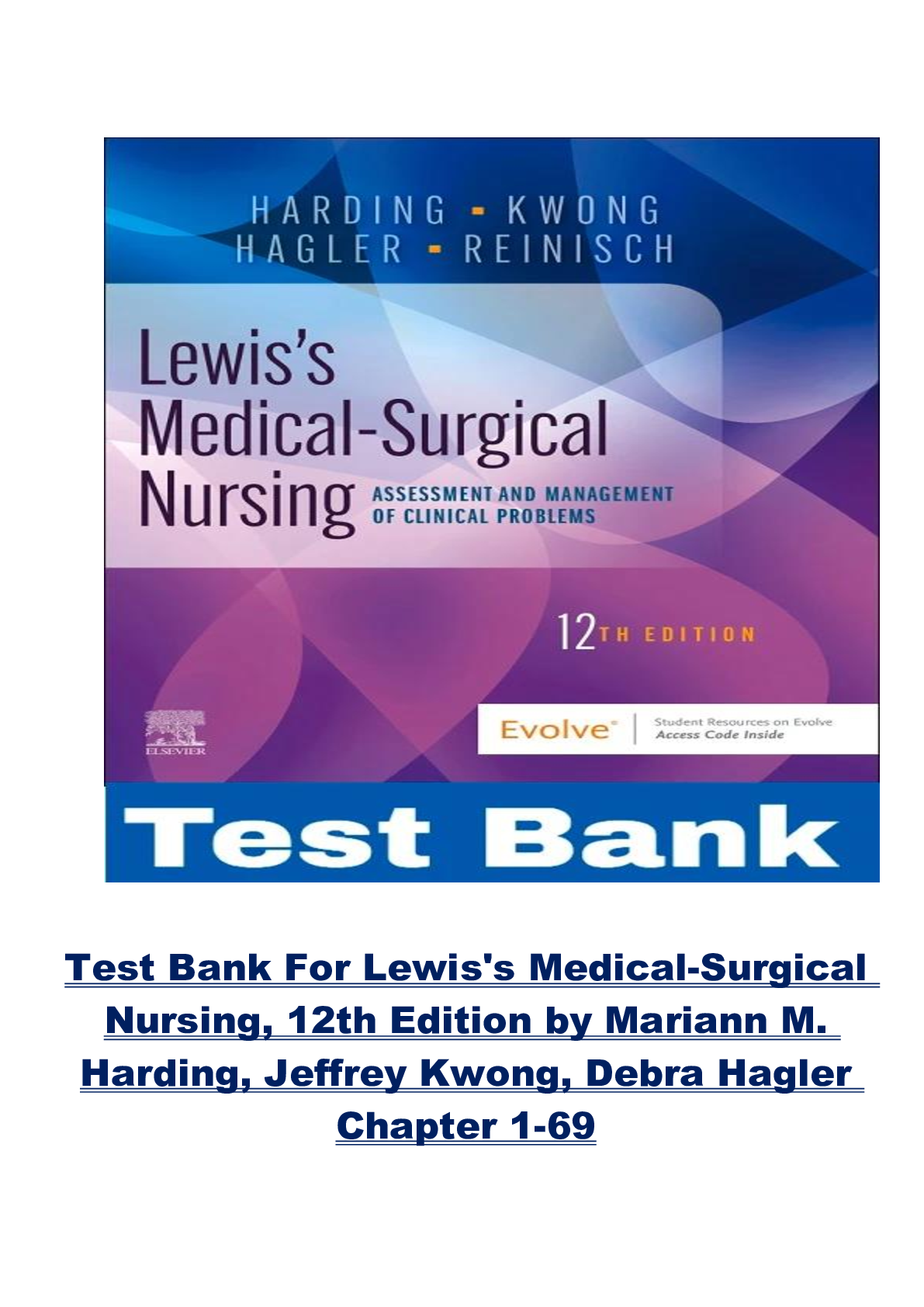
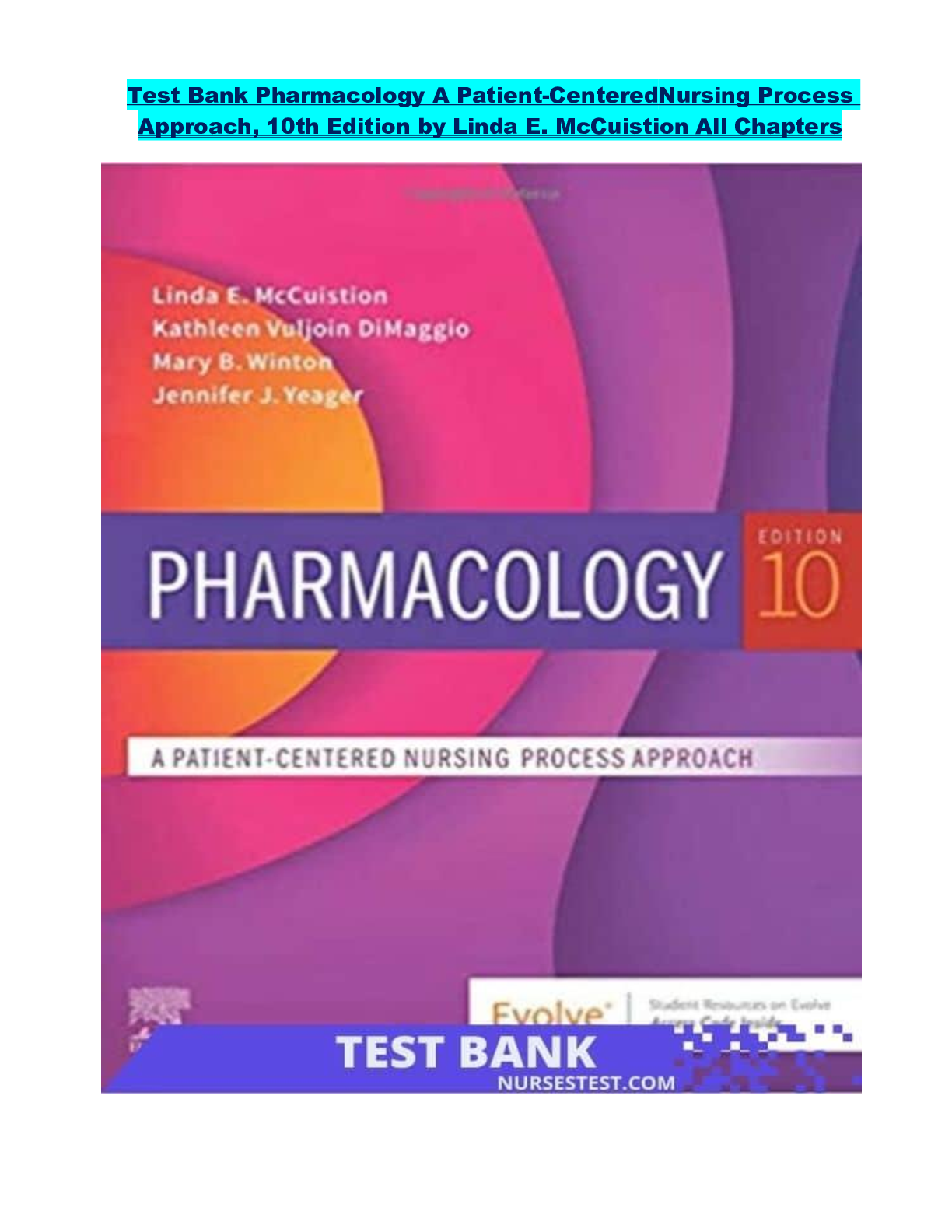


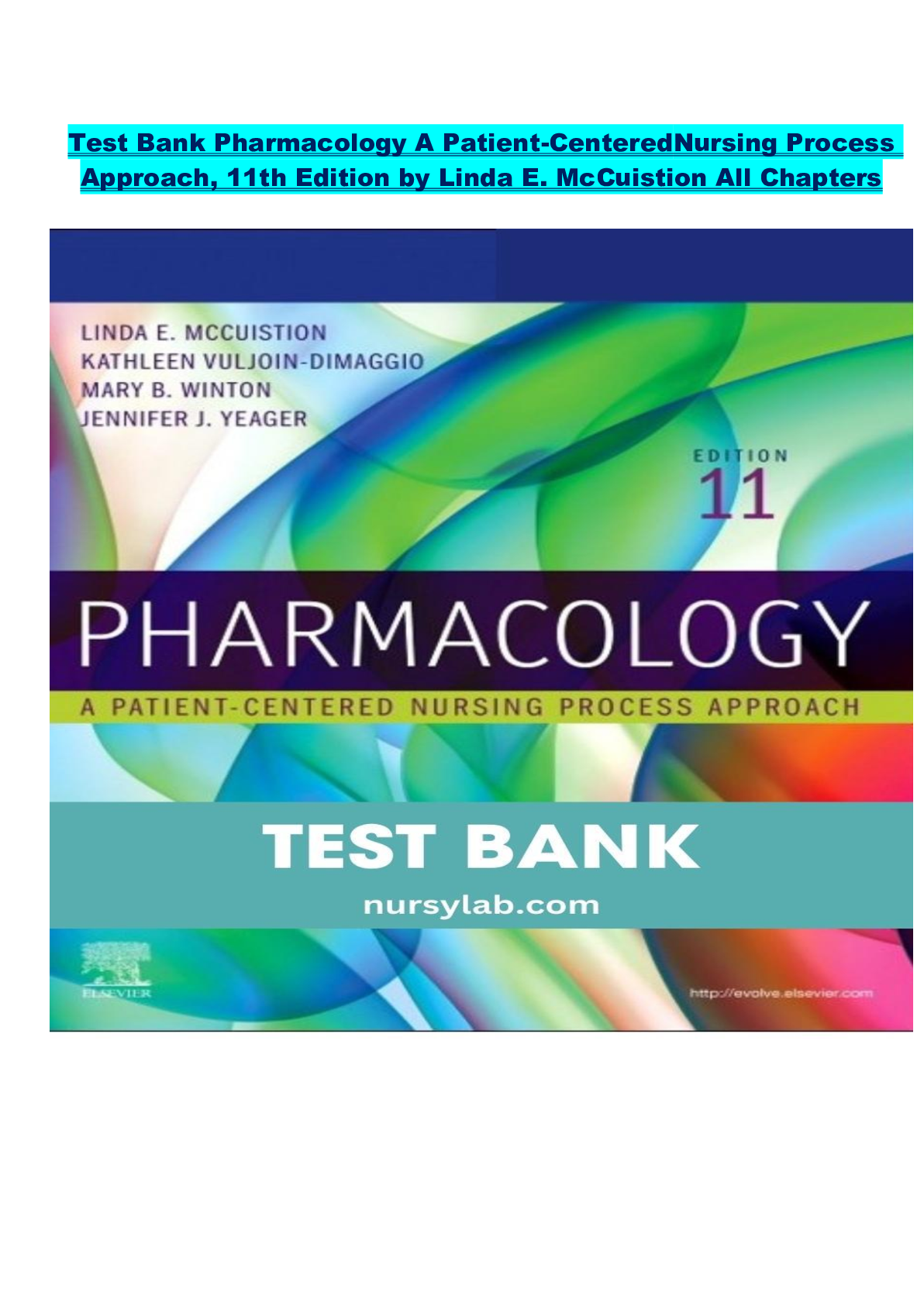
 as.png)
